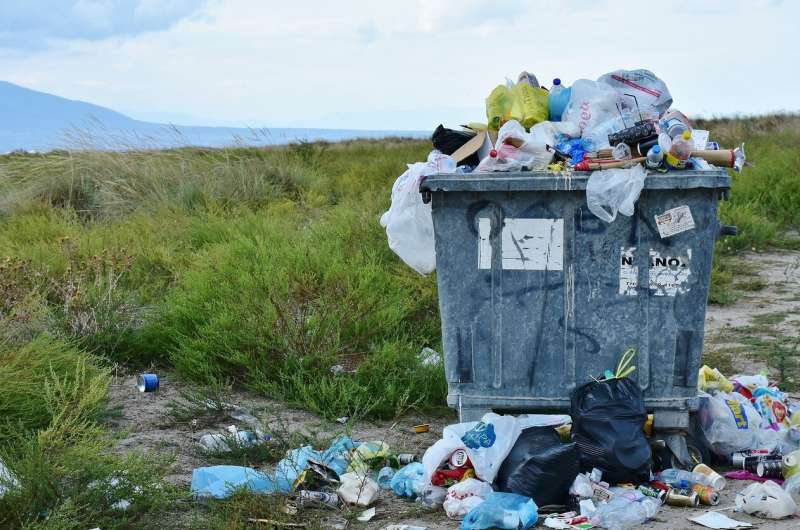A dumpsite is no place for a child: Study shows Nigeria's young waste pickers are at risk

The Olusosun landfill sprawls across 100 acres (40ha) in Nigeria's largest city, Lagos. Initially situated at the outskirts of the city, it is now at the city's center due to urban encroachment. Olusosun is often described as ; it receives over one million tons of annually. Most of this is electronic waste (such as lamps, televisions and laptops), municipal solid waste and construction waste.
Access to the dumpsite is not restricted. Waste pickers can go in and look for recyclable materials that can be resold. In most Nigerian cities, waste picking represents a vital survival strategy for the .
It's not only adults who operate as waste pickers. As we outline in our recent , children are also working at Olusosun.
We surveyed 150 of these child waste pickers; most were boys aged between 13 and 17. More than half (58.7%) of the children were not attending school. They worked at the dumpsite daily for social and economic reasons and their labor was physically taxing. They reported being bitten by insects and snakes. They slipped and sometimes fell. Many suffered from chronic headaches. For this they earned between N500 (US$1.20) and N1,600 (US$3.85) a day.
The use of a child for forced or under section 28 (1) (a) of the Child's Rights Act is an offense punishable with a fine or imprisonment. But in the informal sector of urban areas, Nigeria's government has not made serious efforts to enforce this law to protect children.
A concerted effort is needed by government, civil society, and international organizations to eradicate waste picking by children. Financial aid could be offered to the children's families so that they don't feel they have no option but to let children work. And free, compulsory primary and secondary education is key to keeping children in the classroom rather than working.
Huge health and safety risks
Access to Olusosun landfill is unregulated, but there are informal systems in place to manage who can and cannot engage in waste picking. Our confirmed that before any person could pick waste on this site, they had to register with an association. Unregistered people were not allowed to work on the site and if they did without permission, there would be a quarrel.
An informal association formed by the operators oversees the registration process. It is funded by membership fees and only registers adults. But once they are registered, those adults can hire children to do the work for them. They do this, we were told, to keep their costs low because they could pay children less than they would pay adults.
Information we obtained showed that child waste pickers' minimum daily income was N500 (US$1.20); the maximum was N1,600 (US$3.85). The average daily revenue was N1,180 (US$2.84)—more than N30,000 (about US$72.20) per month. Although this amount is higher than the (N30,000) in the public sector, the work and the environment are hazardous and detrimental to the children's health.
Children usually sorted the waste manually, with no protective equipment like gloves and face masks. They operated in an unsheltered environment regardless of conditions like rain, hot sun and cold weather. These conditions had resulted in gastrointestinal illnesses, skin diseases, stings and bites from insects. Many talked about suffering regular headaches.
Child waste pickers were also at risk of being pricked by sharp objects such as syringes, needles, surgical blades and broken bottles.
Despite all these hazards, the children continued working at the landfill because of chronic poverty. Some of the children's parents were waste pickers themselves. Many came from areas without , sanitation facilities or basic healthcare services.
Recommendations
In addressing the use of children for forced or exploitative labor, integrated approaches have the most success in South Asian countries. (Afghanistan is an important exception.) These approaches can include, for example, conditional cash transfers combined with interventions such as providing education and healthcare services.
Thus, a pragmatic regulatory framework should be developed whereby different actors (government, civil society and international organizations) focus on eliminating the practice of waste picking by children. Such efforts require strong political backing and financial support.
Such a regulatory framework should also make provision for financial aid to the children's parents through a direct assistance program.
There is a need for a well-thought-out plan by the government to introduce free and compulsory primary and secondary education for every child. Making education compulsory, especially at the secondary level, is a way to keep children learning and, ideally, setting themselves up for safe, decently-paid future work.
Provided by The Conversation
This article is republished from under a Creative Commons license. Read the .![]()


















